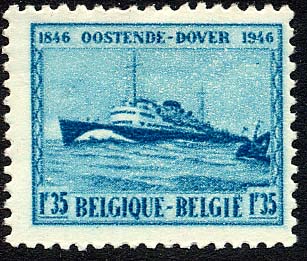Post
by aukepalmhof » Mon Oct 26, 2009 7:32 pm
Built as a ferry under yard No 650 by S.A. John Cockerill at Hoboken, Belgium for the Belgian State Railway.
16 September 1933 launched as the PRINCE BAUDOUIN.
Tonnage 3.050 gross, 1.904 net, 2.351 dwt., dim. 109.9 x 14.2 x 3.4m. (draught).
Powered by two 12-cyl. Sulzer diesel engines, manufactured by builder, maximum power 17.000 bhp, service power 15.000 bhp., twin screws, speed (service) 23.5 knots.
Accommodation for ? passengers.
02 August during her trials she reached a speed of 25.5 knots on the deepwater course between the Outer Ruytingen and West Hinder light vessels. At that time she was the fastest motor ship in the world.
Her astern power was the same as the ahead power and the speed of the PRINCE BAUDOUIN astern was amazing by entering of leaving ports.
Built special for the cross Dover Strait service between Oostende and Dover.
August 1934 completed.
When World War II broke out and Dover under control of the British Admiralty, the service was changed between Oostende and Folkestone until 7 May 1940 when the service was suspended.
17 May 1940 she left for the last time Oostende with refugees for Le Havre.
Then taken up for trooping by the British Admiralty between Southampton and France, her first sailing was from Southampton on 02 June for Brest.
She was one of the ships used in the evacuation from Dunkirk; her last voyage in this evacuation was when she sailed from St Malo on 17th June and arrived Southampton on the 18th.
The plans by the British Admiralty to convert her in a hospitalship fell trough, and from July 1940 was she used as an air target vessel.
In October 1943 converted in a landing ship (LSI: Landing Ship Infantry) by R & H Green & Silly Weir at Tilbury.
Could carry 384 troops and 8 LCA 11 tons landing craft.
Armament at that time of 2 – 12pdrs. and 2 – 2 pdrs. A.A.
Took part in the D-Day landings, she left Weymouth on the 5th June 1944 arrived the 6th Omaha Beach at 03.34 a.m. and left the same day on 16.38 arrived the same day in the Solent on 22.36.
1946 After the war returned to owners and refitted again by Cockerill in a ferry for the service between Oostende and Dover.
1964 Taken out of service.
Then used as a floating office and accommodation ship for construction workers at the Zelzate steel works on the Ghent-Terneuzen canal.
She was broken up by van Heyghen Freres S.A. at Ghent circa December 1967.
Sources: A Century of Cross Channel Passenger Ferries by A. Greenway. B.E.F. Ships before and after Dunkirk by John de S. Winser. The D-Day ships by John de S. Winser. Register of Merchant Ships Completed in 1934.

